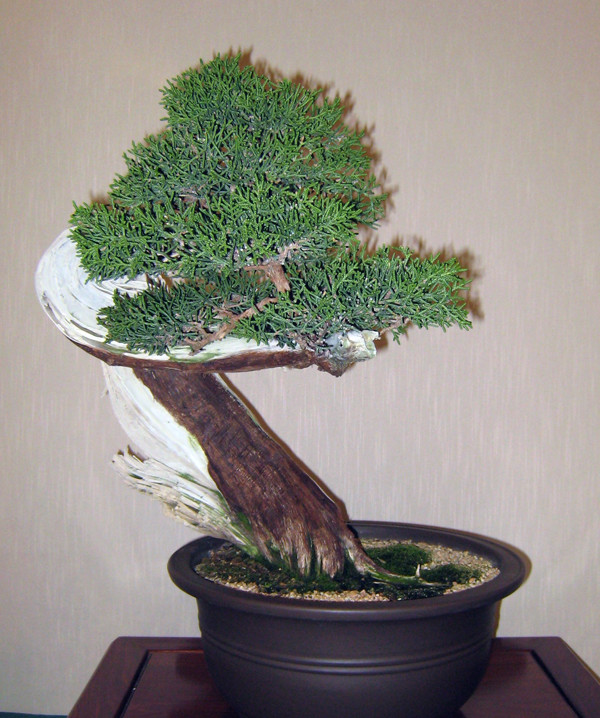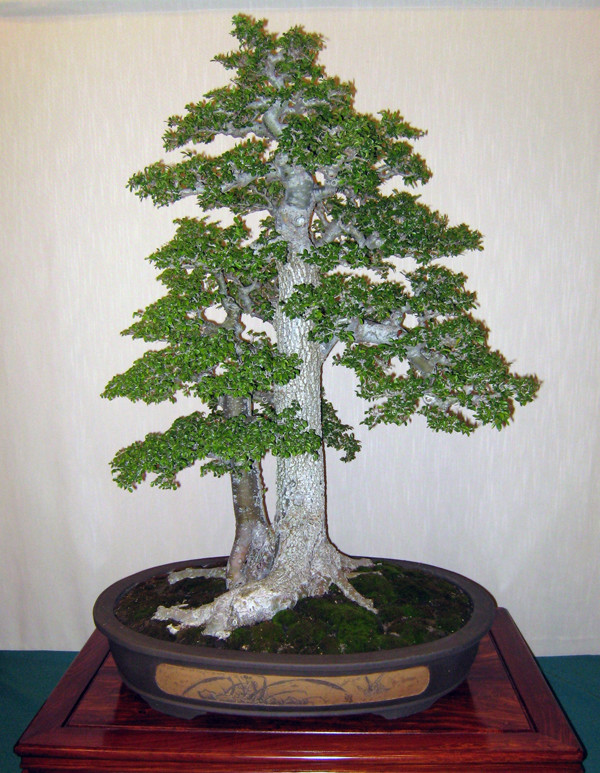February 2008 Newsletter
Presidents Message
It’s Time To Get Involved
By Ken Fuentes
It is my great pleasure and honor to be writing this, my first mes-sage as the new president of the Conejo Valley Bonsai Society. For those of you who don’t know me well, I have been a member of CVBS since 2003 when we were still meeting in founding members’ homes – working mostly behind the scenes doing whatever I could do to help grow the club. This year as president, I plan to work on bringing up other very talented members who are maintaining a low profile to become more involved in our club’s success.
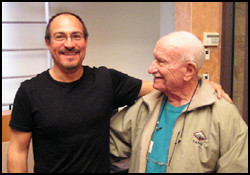 Photo by: David E. Whiteside |
| Outgoing President Nat Stein (right) congratulates incoming President Ken Fuentes … or is it Ken congratulating Nat for getting out of the office after two terms? At the January meeting, Ken was elected president. The official installation of 2008 officers will be at the February meeting. |
But first, I would like to thank Nat Stein, who was president for two terms, 2005 – 2007. He has been a great asset to the club. Because of his incredible connections with other bonsai professionals, he was successful in getting exposure for our young and unheard of club, and I am eternally grateful to Nat for his hard work and for the fact that he is staying on as an advisor. We are also lucky that all other officers, who have done an outstanding job, are remaining in their current positions. And we are fortunate that some of our newer members have stepped up to get involved and have helped us in improving our professional appearance. This includes our incredible Web site and our new newsletter.
So far, February has been a great month for bonsai enthusiasts. The California Shohin Society Seminar Feb. 1 – 3, 2008, was a blast. For those of us who are choosing to move toward smaller and easier-to-handle trees, the expertise and information was well worth the time and modest expense.
Looking ahead, the upcoming Bonsai-A-Thon, the Golden State Bonsai Federation’s annual fundraiser for its collection at the Huntington .
Library and Botanical Gardens in San Marino is going to be a great opportunity not only to view some out-standing examples of the art of bonsai and observe informative demonstrations, but also to purchase some excellent pre-bonsai material.
We recognize that our members range in experience from novice to expert, so we are planning workshops that will best address the group as a whole and focus on techniques for styling and growing based upon experience. To make this a dynamic, ongoing learning process, we would like each member to bring in a tree each workshop meeting. The goal is for each member to have enough material that you will have variety in your collection, and will always have a tree that needs some work.
This is the month that our growing season gets into full swing, so it’s time to set some goals and a schedule, starting with what needs the most attention. It’s a beautiful time of year and a great time to enjoy your bonsai collection. Together, we can make 2008 a grand year for the Conejo Valley Bonsai Society and for your own growing collection of bonsai.
Expert Bonsai Tips
It’s Ideal Time for Potting, Repotting
By Jim Barrett
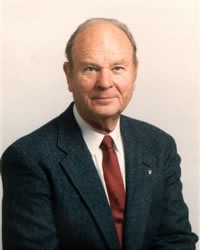 February and March are probably the best two months of the year for potting and repotting bonsai and training trees from nursery cans to bonsai pots.
February and March are probably the best two months of the year for potting and repotting bonsai and training trees from nursery cans to bonsai pots.
Deciding which bonsai needs repotting will depend on how long since its last potting and whether the tree has become root bound.
If the pot does not have a major inside lip, you may want to in-spect the root ball by lifting the tree out of the pot. Look for a firm root ball with roots visible all around the sides and bottom.
Another indication that the tree needs repotting is the soil lifting above the edge of the pot. This shows that a mat of roots has formed on the bottom and is pushing the tree up. Trident maple bonsai are noted for this phenomenon.
One important reason for repotting is the tree has matured beyond its present container. Either it has grown larger or it deserves a more appropriate pot.
There are several things to consider when you decide to proceed:
- Decide which tree or trees you want to pot.
- Choose the pot. And it’s a good idea to have a standby in case the first one doesn’t work.
- Place the wire or heavy plastic screen over each drain hole. Mesh should be at least 1/8-inch holes. Make sure screens are held in place with wire clips to keep them in place.
- If you are going to tie the tree in, now is the time to install the tie wires. Use a wire of sufficient size and strength to do the job.
- Make sure the pot is clean inside and out.
- Have your favorite mix handy.
All of these preparations should be done before the root ball is disturbed. Many bonsai are lost or setback if the roots and soil are removed before everything is ready.
Some hobbyists take just enough soil and roots off to place the tree back in its original pot, leaving room for an inch or so of new soil. Others are more aggressive in cleaning out old soil and prune the roots more severely. Both approaches are valid. It all depends on the condition of the tree, its root system, and the owner’s goals for the tree.
This all sounds pretty involved or complicated – it isn’t, if you use common sense and do not get too rough with the tree.
Aesthetic considerations are:
- Are tree and pot harmonious or appropriate
- Is the tree placed in the pot properly?
- Is the tree planted at the proper angle or attitude?
- Is the front of the tree facing the viewer?
After repotting, place the tree in a shaded area to protect it from the wind. In a week to ten days, place it where you would normally. Wait about a month before fertilizing.
Speaking of fertilizers, you should have started fertilizing with organic fertilizer by now. Miracle Grow and fast-acting fertilizers are best applied at half strength. Time-release and slow-acting chemical fertilizers such as Osmocote and Woodace are safe if you fol-low printed instructions. Some people add these to their soil mix.
Spray Japanese maples and other trees susceptible to powdery mildew with your favorite fungicide. Watch for aphids on apple, quince, and plum. Watch for spider mites on juniper, black pine, and azaleas. Repot wisteria after flowering.
You should be choosing your show trees now. Plan for a bonsai and an accent plant in each display.
Program Notes
Full Schedule Ahead
By Deborah Ervin
As reported last month, meetings for 2008 will be on the third Thursday of each month (see specific dates below). And as you al-ready know, February is a workshop meeting, so be sure to bring at least one tree to work on.
In March, Ted Matson will be our guest demonstrator. He will be working on a raft design from his own collection. Ted is a very popular teacher and is in high demand on the demonstration and bonsai guest speaker circuit. He is also the current president of the Golden State Bonsai Federation.
April will be another workshop, and Dien Liang is slated for May – details in next month’s newsletter. We also are working on details of a tentative trip to visit George Muranaka’s Bonsai Nursery in Nipomo. Discussions of alternative or additional future programs is always in order during regular meetings – so please come prepared with ideas for 2008.
| Meeting | Program |
| February 21 | Workshop – bring your trees |
| March 20 | Ted Matson (demonstrating the raft style) |
| April 17 | Workshop – bring your trees |
| May 15 | Dien Liang |
| June 19 | Workshop – bring your trees |
| July 17 | Roy Nagatoshi |
| August 21 | Workshop – bring your trees |
| September 18 | Jim Barrett |
| October 4 – 5 | CVBS’s Annual Show at Gardens of the World |
| October 16 | Workshop – bring your trees |
| November 20 | Workshop – bring your trees |
| December 18 | Holiday Gathering |
Coming Events
On the Importance of Bonsai-A-Thon XII And the Need for Volunteers
By David E. Whiteside
One of the premier events of the Southern California bonsai com-munity’s annual calendar is the Bonsai-A-Thon at the Huntington Library, Art Collections, and Botanical Gardens in San Marino, on the far east side of the San Fernando Valley. Scheduled for Satur-day and Sunday, February 23 – 24, this fundraiser is essential to supporting the Golden State Bonsai Federation’s (GSBF) world-class bonsai collection/south, which is housed at the Huntington.
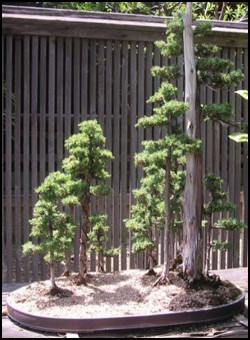 Photo by: David E. Whiteside |
| Foemina Juniper forest by the legendary Ben Oki on display in the Huntington’s bonsai court. |
Launched in 1993, the collection features bonsai masterpieces and viewing stones from noted artists throughout the region. This is a must-see collection, so if you’ve never visited it, this year’s Bonsai-A-Thon is the perfect excuse to make the drive. (There also is a fundrais-er for GSBF’s collection/north in Oakland the same weekend.
While you’re at the Huntington, be sure to take in the existing Japanese garden and the brand-new Chinese garden, which opens that week
The Bonsai-A-Thon itself features displays of many top-quality bonsai; daily demonstrations by some of our region’s leading bonsai artists; a vendors bazaar where you can buy tools, supplies, and trees; classes for both adults and children; and daily raffles and auctions.
Reminder: Nat Stein is helping with the organization of volunteers and he reports that he still needs help, especially on Sunday. Please contact Nat either by e-mail or phone – or, last chance, at the next Conejo Valley Bonsai Society meeting on February 21.



